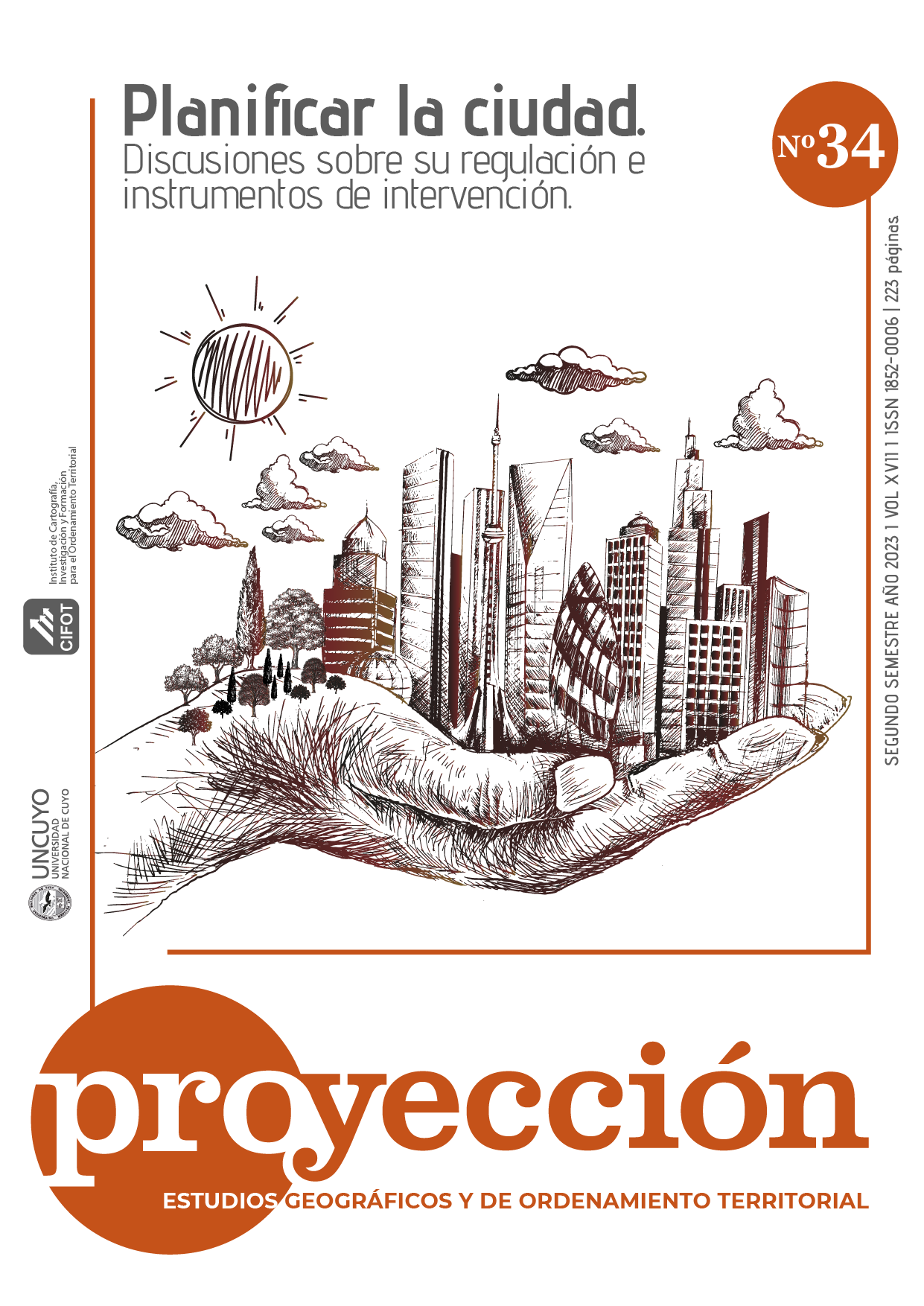Conservation and Vulnerability of a Desert Ecosystem
Based on Landscape Ecology Planning, in San Felipe, B.C. Mexico.
DOI:
https://doi.org/10.48162/rev.55.043Keywords:
Terrestrial Ecosystem, Nature Conservation, Regional Planning, Geographic Information Systems, LandscapeAbstract
Desert landscapes and ecosystems during urbanization processes are prone to be exploited because they are considered arid and unfruitful lands, resulting in their degradation. To analyze these problems and propose solutions, the principles of Landscape Ecology (LE) are used, which allow us to understand the territory from a geographical and holistic perspective. These principles allow the analysis of landscape and to determine its state of conservation and vulnerability, as well as preventing human settlements from being located in risk areas. The methodology is applied in San Felipe, Mexico, located in the Sonoran Desert. The biophysical environment was studied through Intrinsic Suitability Analysis and Geographic Information Systems (GIS). Obtaining as a result that the mountains are the most suitable areas for conservation and with the highest degree of vulnerability, because the most representative factors of the biophysical environment converge, and they are the most fragile areas due to their materials and the presence of geological faults. Determining that, the use of the LE as a basis for planning is recommended because it identifies, and analyzes the components and phenomena that cause interrelationships in the landscape.
References
Ardiles Barbarán, M. K. (2021). Propuesta de vivienda vertical sostenible para reducir la expansión urbana no planificada en la periferia de la ciudad de Huamanga – Ayacucho. Lima, Perú: Universidad Cesar Vallejo.
Belmeziti, A., Cherqui, F., & Kaufmann, B. (2018). Improving the multi-functionality of urban green spaces: Relations between components of green spaces and urban services. Sustainable Cities and Society, 1 - 10.
Belote, T. R., Aplet, G. H., Carlson, A. A., . Dietz, M. S., May, A., McKinley, P. S., . . . Garncarz, J. (2021). Beyond priority pixels: Delineating and evaluating landscapes for conservation in the contiguous United States. Landscape and Urban Planning, 1 - 13.
Climate Data. (2019). Clima de San Felipe, México. Obtenido de es.climate-data.org: https://es.climate-data.org/america-del-norte/mexico/baja-california/san-felipe-4108/
Comisión Nacional de Áreas Naturales Protegidas, (CONANP). (2022). Listado de las Áreas Naturales Protegidas de México. Obtenido de sig.conanp.gob.mx: http://sig.conanp.gob.mx/website/pagsig/listanp/
Environmental System Research Institute (ESRI). (1999). ArcGis Desktop 10.5.0.6491. California, Estados Unidos: Environmental Systems Research Institute.
Forman, R., & Godron, M. (1991). Landscape Ecology. Estados Unidos de América: John Wiley and Sons, Inc.
Instituto Nacional de Estadística y Geografía, (INEGI). (2008). Uso de Suelo y Vegetación [ Carta Digitalizada]. Escala 1:250 000. Obtenido de www.inegi.org.mx: https://www.inegi.org.mx/app/mapas/
Instituto Nacional de Estadística y Geografía, INEGI. (2020). Censo Nacional de Población y Vivienda. Obtenido de www.inegi.org.mx: https://www.inegi.org.mx/programas/ccpv/2020/
Marín, H. C., Bravo Medina, C. A., & Manjarez Fuentes, N. (2017). Análisis de vulnerabilidad ambiental de la cuenca alta del río San Pedro, estado Miranda, Venezuela. Revista Ciencia y Tecnología, 1 - 8.
Martínez Valderrama, J. (2017). ¿Qué sabemos de? Los desiertos y la desertificación. Madrid: Libros de la Catárata.
McCarthy, C., Sternberg, T., Hoshino, B., Banfill, J., Enkhjargal, E., Konagaya, Y., & Phillips, S. (2022). Preserving the Gobi: Identifying potential UNESCO world heritage in Mongolia’s Gobi Desert. Journal of Asia-Pacific Biodiversity, 500 - 517.
McHarg, I. L. (2000). Proyectar con la Naturaleza. México: Gustavo Gil.
Mišovičová, R., & Ružička, M. (2013). Landscape Ecological Planning-Landep I. Biosféra, nitra.
Muñoz Criado, A. (2012). Guía Metodológica de Estudios de Paisaje. Valencia, España: Conselleria de Infraestructuras, Territorio y Medio Ambiente. La Imprente C.G.
Naveh, Z., & Lieberman, A. S. (1993). Landscape Ecology: Theory and Application 2nd Edición. Nueva York, Estados Unidos: Springer;.
Odum, E., & Barrett, G. (2006). Fundamentos de la Ecología, 5a. Edición. México: Thomson.
Periódico Oficial del Estado de Baja California, (POEBC). (3 de Julio de 2014). Programa de Ordenamiento Ecológico del Estado de Baja California. Tomo CXXI, No 34, Número especial. Baja California, México: Gobierno del Estado de Baja California.
Quiroz, D. (2018). mplementación de infraestructura verde como estrategia para la mitigación y adaptación al cambio climático en ciudades mexicanas. México: Secretaria de Desarrollo Agrario, Territorial y Urbano (SEDATU). Deutsche Gesellschaft für Internationale Zusammenarbeit (GIZ) GmbH, 65p.
Roitman, S. (2008). Planificación Urbana y Actores sociales intervenientes: El Desarrollo de Urbanizaciones Cerradas. Revista Electrónica de Geografía y Ciencias Sociales, 1 - 16.
Thompson, G. F., & Steiner, F. R. (1997). Ecological Design and Planning. Nueva York, Estados Unidos: John Wiley & Sons, Inc.
Weißhuhn, P. (2019). Regional assessment of the vulnerability of biotopes to landscape change. Global Ecology and Conservation, 1 - 14.
Zonneveld, I. S. (1990). Scope and Concepts of Landscape Ecology as an Emerging Science. Nueva York, Estados Unidos: Springer-Verlag.
Downloads
Published
How to Cite
Issue
Section
License
Copyright (c) 2023 Karla Posada, Adriana M. Arias-Vallejo, Elvia Oralia Villegas Olivar

This work is licensed under a Creative Commons Attribution-NonCommercial-ShareAlike 3.0 Unported License.
La revista Proyección establece las siguientes condiciones de publicación para los/as autores/as:
- Los/as autores/as conservan los derechos de autor y ceden a la revista el derecho de publicación bajo la Licencia Creative Commons Atribución-No Comercial-CompartirIgual 3.0 No portada (CC BY-NC-SA 3.0) que permite a terceros copiar, distribuir, exhibir y ejecutar la obra citando siempre la fuente y los datos de autoría según la norma prevista por la Revista Proyección. Esta licencia no permite el uso de la obra con fines comerciales.
- Todos los trabajos publicados por Proyección, Estudios Geográficos y de Ordenamiento Territorial serán bajo la modalidad de gratuidad para autores/as y lectores/as.








